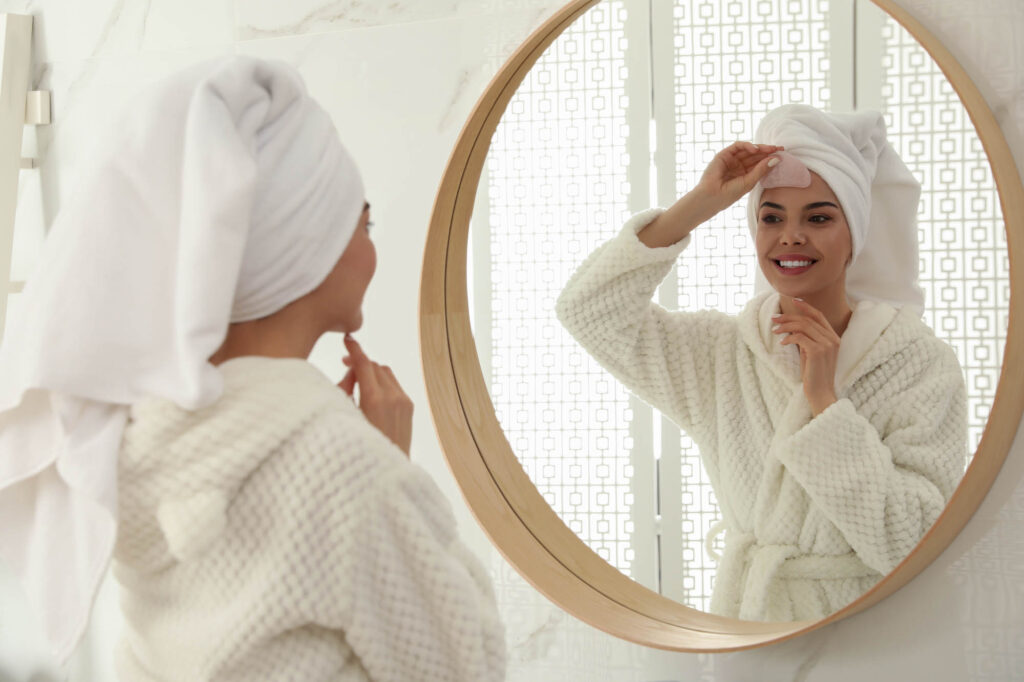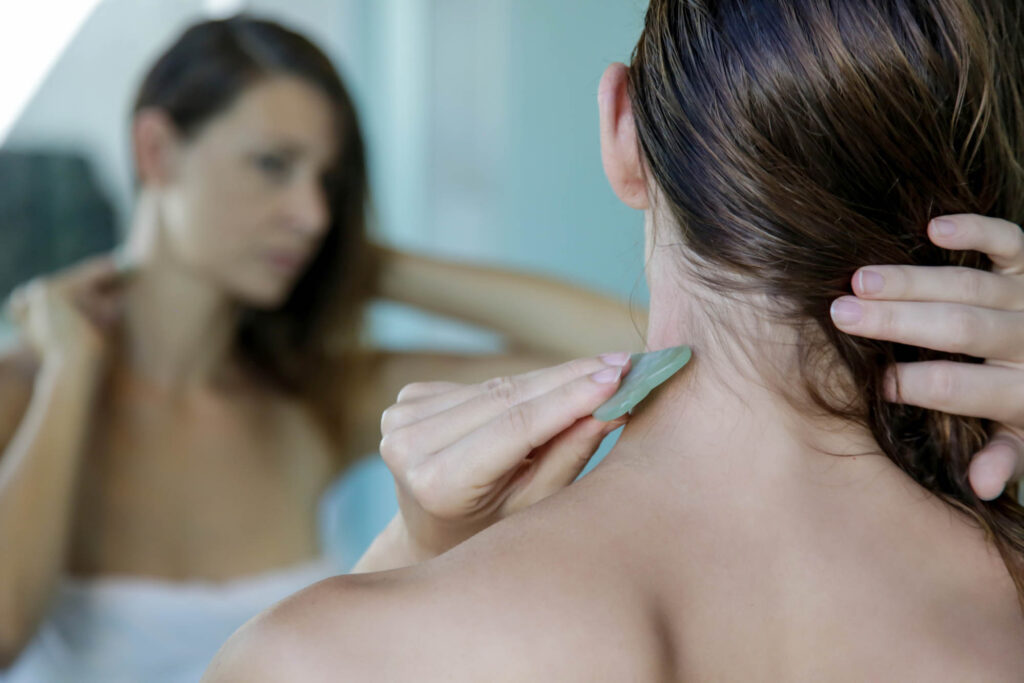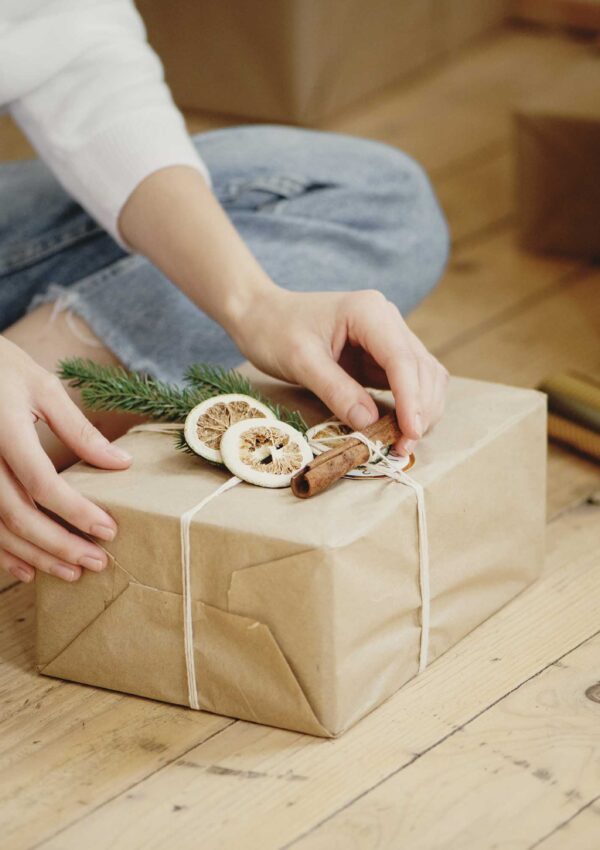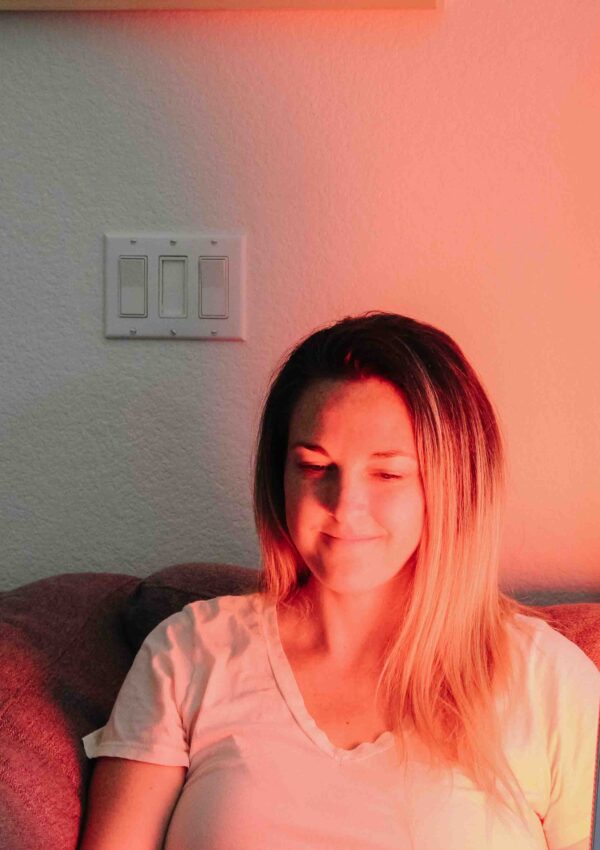Learn how to use facial Gua Sha, how to know which Gua Sha tool to choose and which materials to choose when selecting a Gua Sha stone.

Gua Sha is an ancient Chinese medical practice that can help improve blood circulation, blood flow, and lymphatic drainage, relieve muscle tension, pain, and headaches, and is purported to cure certain diseases. It has been around for centuries in Asia but recently gained popularity in the US thanks to social media.
It has been celebrated as an anti-aging treatment to help erase fine lines, improve skin tone, contour the jawline, relieve tension in facial muscles, and help with sagging skin. Traditional Chinese medicine practitioners perform this in their offices, or you can learn to perform it at home.
Let’s first look at the different Gua Shas available and what the different types do. Then we’ll jump into how to use facial Gua Sha for all its benefits.
Disclaimer: This post includes affiliate links, and we will earn a commission if you purchase through these links. Please note that We’ve linked to these products purely because we recommend them, and they are from companies we trust. There is no additional cost to you.
What different types of materials are Gua Sha stones made from?
Gua Sha stones come in various materials based on your treatment goals. These skincare tools have different qualities based on the materials they are made out of to give extra help during treatments.
- White jade
- Green Jade
- Rose quartz
- Amethyst
- Tiger’s eye
- Aventurine
- Sodalite
- Fire agate
- Bian
- Scolecite
- Black Obsidian
- Opal
- Moonkaite jasper
If you are looking for basic Gua Sha treatments, you can use a smooth wooden, plastic, or porcelain spoon, smooth animal bone or buffalo horn, or a smooth metal cup. You do not want any sharp edges on your tool.
Whatever type of material you select, you will still get the benefits of Gua Sha, just not the extra healing benefits of the gemstones. Be sure to select a material that can be easily cleaned and disinfected to prevent infections, like porcelain, metal, or gemstones. Do not share your tools with other people.
When selecting a Gua Sha tool, consider the material’s ultrasonic pulses, weight, and durability. Many believe that the higher the number of ultrasonic pulses, the more healing properties the material has. For example, bian stone has twice as many pulses as jade.
The heavier the tool, the less pressure you have to apply and the less chance of causing damage, making plastic less ideal than a gemstone. Select a durable and long-lasting tool if you plan on consistently performing Gua Sha daily.
Gua Sha tools are not the same as Jade rollers. Jade rollers only help with circulation and lymphatic drainage. They do not relieve muscle tension or pain.

What shape Gua Sha tool should I use?
It is also vital to consider the tool’s shape for your Gua Sha facial. Gua Sha tools come in various shapes and sizes. Smaller ones are best for the face, while larger ones are better suited for the body.
If you are using the tool on your face, make sure the curves are small enough to allow you to massage the tiny spaces on your face, such as under your eyes. You want the Gua Sha stone to fit the contours of your face.
- “S” shape – This tool is primarily used on the body because of its larger size.
- Fin – This is one of the more popular shapes. It can be used on the body and larger parts of the face.
- Dolphin – Also a popular shape, it is ideal for the body. They even make smaller sizes for facial massage.
- Spoon – This shape works well for the palm, soles, and neck.
- Fish – This small tool is best for deep Gua Sha on the legs.
- Heart – This small tool is perfect for facial Gua Sha. The heart shape is a great beginner’s tool.
- Wave – This smaller tool works best on the jawline, arms, and legs.
- Wand and crescent – These long tools can work the pressure points on the neck and body. Longer tools also make it easier to reach the back and legs.
- Square – This smaller tool is designed for the face. The edges are small enough to get into tiny spots around the eye area.
- Ridges – Tools with ridges are best for the body to break up fascial adhesions.
You should also consider the size of your hands when selecting a face tool. Larger or wider tools are not ideal for smaller hands. If you cannot grip the tool well, you will not get the best treatment. It must be comfortable to hold and maneuver. If it is too large, your hands will tire before completing the treatment.
If you’re looking for a Gua Sha stone tool, Primally Pure and Hugh and Grace both have great jade stones.
Use code JENNIFER10 for 10% off your Hugh and Grace purchase!
What are the different characteristics of the materials?
White jade – White jade stones remain cool throughout the treatment. It helps calm you by giving you peace and harmony and helps reduce puffiness from water retention.
Green jade – Green jade is the most common material for Gua Sha stones and the most prized gemstone in Ancient China. It also remains cool throughout the treatment to impart calming and positivity to the user while protecting the user from negative energy.
Rose quartz – Rose quartz stone was coveted by Cleopatra for its anti-aging benefits. It contains anti-inflammatory properties to help with acne and rosacea and gives soothing vibrations to the user to relieve tension.
Amethyst – Amethyst is thought to have anti-inflammatory properties to help with complexion issues like acne or rashes because it can help soothe inflamed and irritated skin. It can give you clarity of thought.
Aventurine – Aventurine also has anti-inflammatory properties to help with acne and rashes. It can also help calm you during stressful situations and give you energy.
Sodalite – Sodalite is a rare blue volcanic stone that can help calm irritated skin, release tension, and help with logical thinking.
Fire agate – Fire agate is a red stone in the quartz family with anti-inflammatory properties.
Bian – Bian stone is a black stone derived from a mountain in China that was stuck by a meteor. It confers antioxidant properties.
Scolecite – Scolecite can detoxify, decongest, and eliminate negative energy.
Black obsidian – This material comes from molten lava and contains minerals to help reduce inflammation. It also gives you power and self-control to help calm your body.
Opal – This stone is supposed to help with creativity and emotions. It helps release anger and gives you a sense of balance.
Moonkaite jasper – This red-purple stone gives you emotional balance by ridding you of negative thoughts.

How do you use Gua Sha stone on the face?
There are several steps involved in facial Gua Sha. Here is a basic step-by-step guide to help you get started. The more you practice, the better your facial technique will become.
- Inspect your facial tool or stone for damage. Cracks and chips can harm your skin.
- Apply a serum or facial oil to your face. This will prevent damage to your skin from friction and pulling and help the stone glide over your skin effortlessly. If you use an antioxidant serum or oil, the stone will aid in ingredient penetration for enhanced results. If you have sensitive skin, you should try a test spot of the serum or oil on your forearm to make sure it doesn’t irritate your skin or cause an allergic reaction. If you are prone to acne, select a serum or oil that is non-comedogenic. You do not want to clog your pores and get more breakouts. We broke down best facial serums by skin type for more details.
- Do one side of your face at a time. With the flat part of the Gua Sha stone, begin in the center of your chin and move the stone up and out towards the area where the jaw meets the ear. Do this scraping motion 3-5 times with slow, gentle pressure. You can increase the pressure as tolerated. It should not be painful. If it is, you may be exerting too much pressure. You want to move the stone in the direction of the muscle or along the acupuncture meridians.
- Start at the nose and sweep up and out to the cheeks. Follow the contours of the face.
- Next, sweep the under-eye area very gently, moving up and out. You will need to use a small part of the stone for this tiny area.
- Finally, move the flat tool from the center of the forehead outwards and down towards the temples. Do not exert too much pressure over prominent bones, like the brow bone. It will hurt. The important thing is to stop if you feel pain.
- After the treatment is complete, rest. Avoid strenuous activities. Drink plenty of water. Avoid direct sunlight until the redness and bruises fade. Do not shower for 24 hours. Avoid extreme heat and cold for 24 hours. Clean and disinfect your stone to prevent infection.
- Avoid using it over areas of active infections, skin lesions, and rashes.

What oil should I use with Gua Sha?
There are many facial oils or serums to choose from. Facial oils and serums help the tools glide effortlessly over the skin’s surface to prevent damage. Gua Sha will enhance the penetration of the ingredients in your products.
Make sure the fragrance is not too overpowering. Always try a test spot before using the product all over your body in case it irritates your skin or causes an allergic reaction. This is an especially critical step if you have sensitive skin. Also, if you are acne prone, select a non-comedogenic one.
When first starting Gua Sha, begin with a hydrating oil or lotion, like rosehip. This will help hydrate your skin while performing Gua Sha. As you become more advanced, you can also choose products that brighten your complexion, like vitamin C, or protect your skin with ingredients such as antioxidants, like vitamin E.
If you have sensitive skin, select a calming lotion or oil that contains ingredients like camellia or jojoba oil.
Use code JENNIFER10 for 10% off your Hugh and Grace purchase!
How often can you use Gua Sha stone?
Gua Sha should be performed daily as part of your nighttime ritual after cleansing and moisturizing your face. The best results come from regular, consistent use.
Even if you can only do it three times a week, you will still get some benefits. The more you make it part of your skincare routine, the better the results. However, once a day is sufficient. You do not want to overdo it and damage your skin.
Can you use Gua Sha stones on other parts of the body?

Gua Sha stones are not just for facial use but can be used on the neck and body to deliver firm pressure. It will confer the same benefits to the body and neck as to the face. It helps relieve tension and inflammation, reduce pain, and alleviate muscle aches. Just follow the length of the muscle with short strokes.
Neck:
- Start by applying oil or serum to your neck.
- Start at the area where your scalp meets the ears. Sweep the stone down towards the base of your neck. Do this with the curved part of the Gua Sha stone, 5-10 times with slow mild pressure. You can increase the pressure as tolerated. It should not cause pain.
- Now do it on the other side.
- The same aftercare applies to you and your stone mentioned above.
If you do it to your back, start at one side of your neck and sweep down towards your hips. You can even do it to your abdomen and chest. Work from the bottom upwards. Do not scrape the stone over bones or nipples.
If you want to perform Gua Sha on your legs and arms, do one at a time. Start at the ankles and sweep up to the knees and then thighs. Start at the wrists and sweep up to the elbows and then shoulders.
The bottom line
Gua Sha is an ancient Chinese treatment to help increase blood flow and lymphatic drainage. Practitioners believe it rids the body of stagnant, toxin-ridden blood through the lymphatic system and brings in new blood filled with oxygen and nutrients to heal the damaged area of the body.
Other reported benefits of the regular use of Gua Sha include improving the appearance of the face by reducing fine lines, facial puffiness, and sagging skin. There are not a lot of large studies confirming these benefits of Gua Sha.
The more you practice, the better your Gua Sha technique will become. Experiment until you discover the most effective ways to help yourself. Always check with your doctor first before starting Gua Sha.
Take action
If you want to try Gua Sha, start slowly with a good tool. Begin with very little pressure and a minimal number of strokes to see how your skin and body will react to it. If you start to feel pain, this is a reason to stop and reevaluate your technique. You do not want to do more harm than good.
For more information and resources on facial Gua Sha, check out these posts:
How to Find the Best Facial Serum for Gua Sha
12 Surprising Benefits of Facial Gua Sha From a Dermatologist
If you’re looking for a Gua Sha stone tool, Primally Pure and Hugh and Grace both have great jade stones.
We did a review of Hugh and Grace (a plant-based product line with great serums) here, which breaks down their different plant-based serums and what we love (and don’t) about them.
Use code JENNIFER10 for 10% off your Hugh and Grace purchase!
References
Chen T, Liu N, Liu J, Zhang X, Huang Z, Zang Y, Chen J, Dong L, Zhang J, Ding Z. Gua Sha, a press-stroke treatment of the skin, boosts the immune response to intradermal vaccination. PeerJ. 2016 Sep 14;4:e2451.
Kwong KK, Kloetzer L, Wong KK, Ren JQ, Kuo B, Jiang Y, Chen YI, Chan ST, Young GS, Wong ST. Bioluminescence imaging of heme oxygenase-1 upregulation in the Gua Sha procedure. J Vis Exp. 2009 Aug 28;(30):1385.
Marion T, Cao K, Roman J. Gua Sha, or Coining Therapy. JAMA Dermatol. 2018 Jul 1;154(7):788.
Nielsen A. Gua sha research and the language of integrative medicine. J Bodyw Mov Ther. 2009 Jan;13(1):63-72.
Nielsen A, Kligler B, Koll BS. Safety protocols for gua sha (press-stroking) and baguan (cupping). Complement Ther Med. 2012 Oct;20(5):340-4.
Nielsen A, Knoblauch NT, Dobos GJ, Michalsen A, Kaptchuk TJ. The effect of Gua Sha treatment on the microcirculation of surface tissue: a pilot study in healthy subjects. Explore (NY). 2007 Sep-Oct;3(5):456-66.
Park SW, Kwak HB, Lee SK, Jung ES, Park SK, Lee J, Lee HS, Yun SK, Kim HU, Park J. Cutaneous Mycobacterium massiliense Infection Caused by Skin Coining ‘Gua Sha’ in Korean Healthy Female. Ann Dermatol. 2021 Dec;33(6):572-576.
Wiwanitkit V. Culture-Bounded Skin Lesion – A Case Due to Chinese Gua Sha. Indian J Dermatol. 2017 Jul-Aug;62(4):441.





Leave a Reply